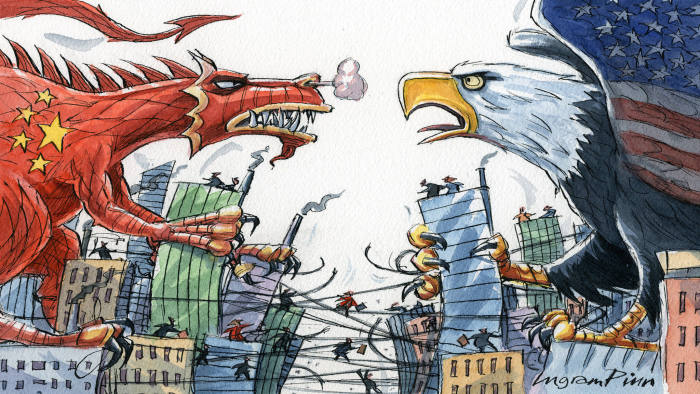
Business will be the loser in the US-China fight
Both nations are indispensable, so companies face a two-track world
by Robert ArmstrongIt is an old joke among international business people that in China, a win-win deal means that China wins twice. This was never entirely true, of course. If it was, so many corporate supply chains and investment projects would not run through the country. But cratering relations between China and the US have left global businesses confronting lose-lose propositions.
In the past few months, the two sides have exchanged blame and conspiracy theories over Covid-19. The US Senate passed a bill that could force some Chinese companies to drop their US listings. The commerce department has tightened rules against Chinese telecoms champion Huawei, leading China to consider retaliation. Security legislation imposed on Hong Kong has threatened that city’s status as the main commercial link between China and the world.
This is not just a problem for US and Chinese companies. The new controls on Huawei, for example, are a threat to all global chipmakers that supply the company — they all depend on US chipmaking tools. Mercedes and BMW export cars from the US to China. The list goes on, and companies are scared. “While we are nowhere close to the same level of hostility yet, we have seen how the US punishes European companies who deal with Iran and Russia,” says Joerg Wuttke, president of the EU chamber of commerce in China.
This is not merely a rough patch, or passing hostility stirred up by the pandemic. Even before this terrible spring, politics and corporate attitudes were in flux. In a survey last summer of members of the American Chamber of Commerce in Shanghai, 21 per cent were pessimistic about the five-year outlook for business in China. Since 2000, that figure had not risen above 9 per cent.
The Chinese market is too large, with companies invested too heavily, for them to consider bailing out. But the trend towards two-track corporate strategies is accelerating. As crossing the border becomes trickier, companies are taking a “for China, in China” approach to the domestic market while deepening and diversifying ex-China supply chains to the rest of the world.
China is exacerbating the split, in deeds if not words. Business people report that Beijing remains eager to please US companies that are investing in China. But, says Mr Wuttke, “while investors get the red carpet, exporters from the US get hammered, because exporters can be substituted”. This fracturing will accelerate as Covid-19 has laid bare supply chains’ monolithic dependence on China. Resilience is bought at a cost to efficiency.
In hardware, companies face impossible dilemmas. They depend on China’s vast market and its unparalleled manufacturing base in mobile technology. US chipmaker Qualcomm has supplied Huawei with chips for its phones. Whether it will be able to do so with the latest 5G models is unclear, given the new rules. If it does, it will be sharing cutting-edge US technology with a company that stands accused of appropriating American intellectual property and which has close ties to China’s military.
If Qualcomm cannot supply Huawei, it will cede market share to foreign rivals and lose billions in revenue (Huawei shipped 240m smartphones last year, more than Apple). This will inevitably reduce its research budget. US leadership in tech will be eroded.
China may respond. Authorities have revived the idea of an “unreliable entities list” for companies such as Qualcomm, Cisco, Apple and Boeing — the equivalent of the commerce department’s “entity list” of companies posing a risk to US national security. “Scalps are going to be taken on both sides — there is no way to avoid this,” says the chief executive of a US multinational with a long history in China. Other than keeping their heads low, making their case to officials, and diversifying, there is little companies can do but hope. But they should not pin those hopes on Donald Trump losing November’s election. The president is not the cause of the bad relations, even if his rhetoric gives them an ugly face.
In its actions China has never shown any intention of participating in the international model of open economies, independent companies, global rules and respect for intellectual property. It will not start thinking win-win now. Nor will the US military allow their supply of the best communications technology to depend on a geopolitical rival. “Semiconductors are the most important national security industry of the 21st century, and the Department of Defense does not want it to move offshore — yet much of it already has,” says Peter Lichtenbaum, a lawyer who helps companies navigate US trade restrictions.
US hostility to China has roots in deep economic imbalances. As Peking University economist Michael Pettis argues, the issue is not a trade imbalance that can be solved with tariffs, but the fact that China and other countries force their excess savings into the open US capital market, forcing up the dollar, US debt and inequality. While in a post-Trump world the dialogue may be “less stupid”, he says, “these problems are not going away”.
Global companies cannot leave China. But they should prepare for a two-track world. Sino-American economic relations are bad and are set to stay that way.
robert.armstrong@ft.com